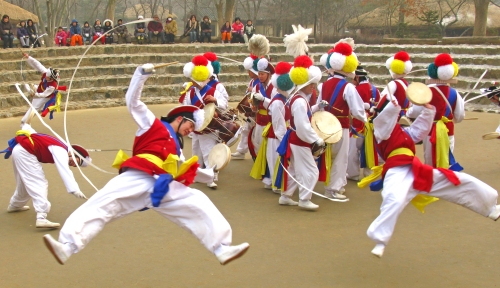
Isang Yun’s youth was dominated by his involvement with resistance movements against the Japanese occupation of Korea, which began in 1910. His political activities deeply affected his development as a musician, which was characterized by the constant conflict between his artistic interests and the political commitment that he felt was necessary. Nevertheless, at the age of 17, Yun traveled to Japan, despite his father’s warning, to embark on a college education focused on the study of Western music. After two years, he returned to Korea to continue his studies and his involvement in the Korean liberation struggle. Yun was arrested by Japanese occupation forces in 1943, and it was not until 1948 that he returned to music, this time as a music teacher at an all-girls high school in his hometown. He later began lecturing at a university in Seoul where he received several awards for his compositions.
These awards enabled Yun to continue studying music in Europe at the Berliner Hochschule für Musik (Berlin University of Music). His frequent participation in Darmstadt’s summer courses for new music led to his acceptance by the European avant-garde, within which he remained an outsider, albeit a respected one. Yun settled in Berlin in 1964 as a Ford Foundation scholarship recipient but the political conflict in his now divided homeland was never far from his thoughts. He was especially critical of South Korea’s leadership and refused several invitations to perform there. Yun hoped for the reunification of Korea, and to make this happen, he made a daring visit communist North Korea in 1963.

The brazen visit concerned South Korean officials, who had Yun kidnapped from Berlin in 1967 in a spectacular operation by the South Korean secret service. He was charged with treason and sent to prison where he endured torture, attempted suicide, and was forced to confess to espionage. After a trial, Yun was sentenced to life imprisonment, a charge that was later revised after massive protests internationally. Subsequently, Yun left Korea in 1969 and returned to Berlin and later became a German citizen. From 1970 onward, he worked as a professor and taught composition while lecturing on various occasions throughout Europe and North America. In 1972, Yun composed the piece Sim Tjong based on a popular Korean fairytale specially for the 1972 Olympic Games in Munich. When asked in a 1987 interview whether he was consciously trying to combine Asian and Western elements in his music, Yun replied,
“No, that would be too artificial. The inner truth is, in actuality, a music of the cosmos. Realistically seen, I’ve had two experiences, and I know the practice of both Asian music and European. I am equally at home in both fields. I’m a man living today, and within me is the Asia of the past combined with the Europe of today. My purpose is not an artificial connection, but I’m naturally convinced of the unity of these two elements. For that reason, it’s impossible to categorize my music as either European or Asian.”
Celebrate Asian Pacific Islander Heritage Month by reading the entry on Isang Yun (also spelled Yoon) in MGG Online. Listen to Yun’s composition Muak dance fantasy below.










